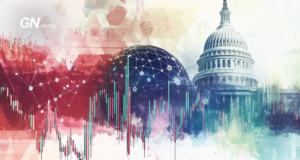Fed Says It’ll Slow Rate Cuts—Markets React Badly

The Federal Reserve’s latest announcement dropped like a bombshell. Stocks tumbled on Wall Street and in Asia. Even Bitcoin took a nosedive.
On this page
Yes, the rate was cut, and it was expected. However, by signaling a slower pace of rate cuts for next year, the Fed sent shockwaves through financial markets across the globe.
So, what’s behind all this turmoil?
A Shift in Strategy
At its year-end meeting, the Fed cut its benchmark rate by 0.25 percentage points, landing it between 4.25% and 4.50%. No surprises there. But here’s the kicker: instead of cutting rates by a full percentage point next year, as previously forecast, the Fed now plans to trim just half a point. Why the change? Inflation—it’s still hanging around like an uninvited guest.
Historically, this kind of cautious approach from the Fed has had mixed results. Back in the 1970s, aggressive rate moves helped curb inflation but also led to high unemployment and stagnation. Balancing growth with price stability isn’t easy, and if public confidence wanes, it could throw the economy off track.
Related: How does inflation in the U.S. affect Bitcoin?
How Are Markets Taking the Fed Rate Cuts?
Not well. The U.S. dollar surged, pushing the euro down to $1.0344. Treasury yields shot up too, with the 10-year hitting 4.49%. Stocks? The Dow fell 2.6%, with Japan’s Nikkei and Germany’s DAX also taking hits. Are we heading for a rough 2025?
The rising rates are causing headaches for companies that rely heavily on debt, like those in tech and real estate. Borrowing is pricier, and that could mean budget cuts, layoffs, or worse. And let’s not forget consumer-dependent sectors—with tighter wallets, spending is bound to take a hit.
Reaction of stock indices to the Fed press conference Source Yahoo
Cryptos and Gold Under Fire
Bitcoin, fresh off a record high of $108,364, plunged to $100,200. Ethereum followed suit, dropping over 7% to $3,356. The entire crypto market shrank as investors hit the brakes. Why gamble on cryptos when bonds suddenly look more appealing? Gold didn’t fare much better, slipping $50 to $2,587 an ounce.
Why do cryptos feel the pinch so hard? They’re speculative—high risk, high reward. Rising rates make safer investments like bonds more attractive. But as institutional players like banks get deeper into Bitcoin, volatility might ease over time.
Still, the crypto market isn’t going anywhere. Blockchain’s potential in decentralized finance (DeFi) and NFTs keeps drawing interest. Could it be that the market’s long-term success hinges on clearer regulations and wider adoption?
And gold? It’s been a trusty safety net for centuries. Even though prices dipped this time, history shows it usually shines when the going gets tough.
Related: Bitcoin Falls Below $100K as Jerome Powell Speaks
Inflation vs. Growth—The Fed’s Tightrope
Fed Chair Jerome Powell laid it out: rates can’t stay high forever, but cutting them too soon risks letting inflation run wild again. It’s a delicate dance. Inflation peaked at over 9% in mid-2022, prompting the Fed to raise rates at breakneck speed. While prices have cooled, Powell isn’t popping the champagne just yet.
But here’s the twist: sluggish growth in places like China and the Eurozone adds another layer of uncertainty. Could global troubles end up influencing U.S. policy more than we’d like?
Related: Arthur Hayes Predicts BTC Surge Driven by China
Trump’s Trade Tariffs—Another Wild Card
And then there’s Trump. His proposed trade tariffs could disrupt supply chains and fan the flames of inflation. Powell wasn’t exactly reassuring, admitting it’s too early to predict the fallout. What goods will be taxed? How will other countries react? For now, it’s a big question mark.
Experts warn that these protectionist moves could shake up global trade in ways we haven’t seen before, breaking alliances and raising costs for everyone.
Looking Ahead—More Questions Than Answers
Powell remains optimistic about the U.S. economy, predicting 2.5% GDP growth this year and 2.1% in 2025. A strong labor market and healthy corporate earnings provide some breathing room. But will that be enough?
Trends in corporate spending and consumer habits could give us early clues about how businesses and households adapt to prolonged high rates.
The road ahead looks bumpy. Volatility is the name of the game as markets grapple with policy changes, geopolitical shifts, and trade uncertainties. Can the Fed juggle all these challenges without dropping the ball?
One thing’s for sure: unexpected disruptions—whether from climate change or geopolitics—could throw everything into chaos. How prepared are we for the unexpected?
Related: Bitcoin Volatility Index: What is it and how to use it?
The content on The Coinomist is for informational purposes only and should not be interpreted as financial advice. While we strive to provide accurate and up-to-date information, we do not guarantee the accuracy, completeness, or reliability of any content. Neither we accept liability for any errors or omissions in the information provided or for any financial losses incurred as a result of relying on this information. Actions based on this content are at your own risk. Always do your own research and consult a professional. See our Terms, Privacy Policy, and Disclaimers for more details.


























